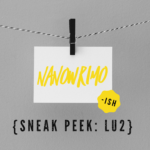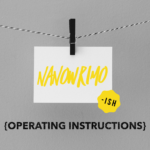Please welcome guest blogger, Laura L. Smith (aka, my writing buddy) as she talks about how she writes characters and gives us a jump-start this NaNoWriMo by writing character descriptions of ourselves.
**
Character Descriptions, by Laura L. Smith
My novels all begin in my head with an abstract idea of a girl facing a certain life issue in a specific setting, usually someplace fabulous I’ve traveled to. The issue and the setting lodge in my brain and won’t let go. Once I realize this is something I have to write about, I spend a large chunk of time working out a character description.
Who is going through this thing in this place? What is she like? Who are her friends? Are they the right friends for her? What’s her family like? How do they treat her? What will delight her, concern her, energize her, wear her out? I need to have a character fully in my head before I can write about how she’ll act and react to all of the things that will happen to her in the course of a story.
My definition of a character description is:
- How the character sees herself AND
- How others see her
I require both of these viewpoints, because like a real person, my character will miss some of her own characteristics, and the people around her will often miss some of my character’s finer (and less fine points) that only she can see.
I begin with what my character looks like. I need to be able to picture her. I might people watch for a few hours at a public park or the campus student center. I’ll usually pick out a girl who embodies the character that would need to go on the journey of the story of my book, seal her in my mind, and go from there. When I wrote Angry, my main character had a fiery personality, so I wanted a redhead to embody that trait. When I wrote about Claire, in my Status Updates books, I scrolled through pictures on Google for hours until I found the right petite and pale image who would be essential to the fragility of Claire’s character arc. And when I found her—wow, it was like she was sitting next to me.
Once I know what my protagonist looks like, I sketch out her hobbies, quirks, favorite foods, who she lives with, what that silly thing is she’s afraid of that she knows she shouldn’t be (for me this is mice—eek!). There’s the kind of music she listens to, the books she reads, her pets, allergies, siblings, her nervous twitches. Does she rub her hands on her thighs when she’s thinking or tuck her hair behind her right ear when slightly uncomfortable. You get the picture.
And if I’ve done my writing job right, this really cool thing happens. The more of the bad habits, anxieties, and rawness I develop for the character, the more beautiful she becomes. She becomes real, not a cardboard cutout person, but like me or like you, she becomes someone who has real concerns. There are things that haunt her and bother her, little things that amuse her for no apparent reason. She has feelings, and at the core of it all—she longs to be loved.
A great way to practice writing character descriptions is to write your own. Start with an outline of yourself—name, age, where you live, who you live with, physical description, favorite color, etc. Dig deeper by writing the name of your best friend and explaining why they’re your best friend, what your favorite food is and where you like to get it, what show you’re hooked on and how that show makes you feel. List the places you feel happiest and the activities that drain you. As you spend more time writing about your habits, the things that bring you joy, the way you react to certain things, you’ll hopefully not only better understand how to write a character description, but also better understand yourself and how you tick.



Wonderful insight into the mind of a writer. Each approach is as unique as the writer.
Thanks Jim. Writing character descriptions is one of my favorite parts about crafting a novel.
Thanks for hosting me on your blog, Beth! So fun to chat about creating characters 🙂
Feel free to pop on by every week.